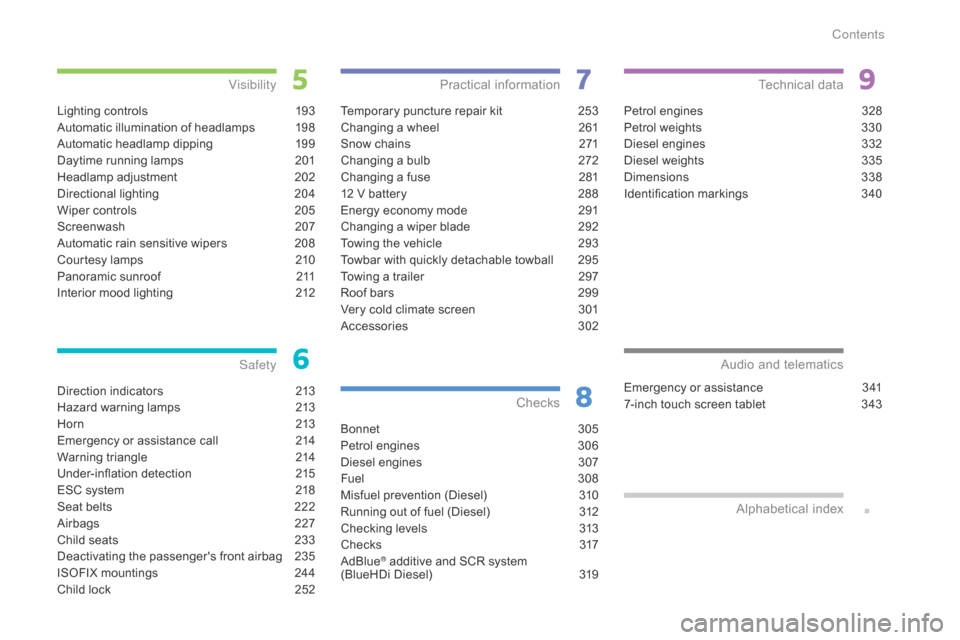emergency towing Citroen C4 PICASSO RHD 2014.5 1.G Owner's Manual
[x] Cancel search | Manufacturer: CITROEN, Model Year: 2014.5, Model line: C4 PICASSO RHD, Model: Citroen C4 PICASSO RHD 2014.5 1.GPages: 428, PDF Size: 10.03 MB
Page 5 of 428

Direction indicators 213
Hazard warning lamps
2
13
H or n
2
13
Emergency
or assistance call
2
14
Warning
triangle
2
14
Under-inflation
d
etection
2
15
ESC
system
2
18
Seat
belts
2
22
Airbags
2
27
Child
seats
2
33
Deactivating
the passenger's front airbag
2
35
ISOFIX
mountings
2
44
Child
lock
2
52
Safety
Temporary puncture repair kit 253
Changing a wheel
2
61
Snow
chains
2
71
Changing
a bulb
2
72
Changing
a fuse
2
81
12
V battery
2
88
Energy
economy mode
2
91
Changing
a wiper blade
2
92
Towing
the vehicle
2
93
Towbar
with quickly detachable towball
2
95
Towing
a trailer
2
97
Roof
bars
2
99
Very
cold climate screen
3
01
Accessories
3
02
Practical information
Bonnet 305
Petrol engines
3
06
Diesel
engines
3
07
Fuel
3
08
Misfuel
prevention (Diesel)
3
10
Running
out of fuel (Diesel)
3
12
Checking
levels
3
13
C h e c ks
3
17
AdBlue
® additive and SCR system
(
BlueHDi Diesel) 3 19
Checks
Petrol engines 3 28
Petrol weights
3
30
Diesel
engines
3
32
Diesel
weights
3
35
Dimensions
3
38
Identification
ma
rkings
3
40
Technical data
Emergency or assistance 3 41
7-inch touch screen tablet
3
43
Audio and telematics
Lighting controls 1 93
Automatic illumination of headlamps
1
98
Automatic
headlamp dipping
1
99
Daytime
running lamps
2
01
Headlamp
adj
ustment
2
02
Directional
l
ighting
2
04
Wiper
controls
2
05
Screenwash
2
07
Automatic
rain sensitive wipers
2
08
Courtesy
lamps
2
10
Panoramic
sunroof
2
11
Interior
mood lighting
2
12
Visibility
Alphabetical
in
dex
Contents
Page 138 of 428

136
Emergency braking
In the event of a failure of the main service brake or in an exceptional situation (e.g. driver
t
aken ill, under instruction, etc) a continuous
p
ull on the control lever will brake the vehicle.
B
raking takes place while the control lever is
b
eing pulled. It is interrupted if the control lever
i
s
r
eleased.
The
ABS and DSC systems provide stability of
t
he vehicle during emergency braking.
If
the emergency braking malfunctions, the
m
essage "Parking brake control faulty" will be
d
isplayed.
If
a failure of the ABS and DSC systems
o
ccurs, signalled by the illumination of one
o
r both warning lamps in the instrument
p
anel, then stability of the vehicle is no longer
g
uaranteed.
In
this event, stability must be assured by the
d
river by repeating alternate "pull-release"
a
ctions on the control lever until the vehicle is
immobilised. The
emergency braking should only be
u
sed in an exceptional situation.
Repeat
this
procedure
to
reactivate
automatic
ope
ration.
Reactivation
of
automatic
operation
is
c
onfirmed
by
the
indicator
lamp
in
the
i
nstrument
panel
going
off.
Deactivating automatic
operation
In some situations, such as very cold weather o r towing (caravan, recovery), it may be
n
ecessary to deactivate automatic operation of
t
he system.
F
S
tart the engine.
F
A
pply the parking brake with the control
l
ever, if it is released.
F
T
ake your foot off the brake pedal.
F
P
ush and hold the control lever in the
r
elease direction for at least 10 seconds
a
nd no more than 15 seconds.
F
R
elease the control lever.
F
P
ress and hold the brake pedal.
F
P
ull the control lever in the apply direction
f
or 2 seconds.
Deactivation
of the automatic functions
i
s confirmed by illumination of this
i
ndicator lamp in the instrument panel.
F
R
elease the control lever and the brake
ped
al. From
this point the parking brake can only b
e applied and released manually using the
c
ontrol lever.
Driving
Page 215 of 428

213
Direction indicators
F Left: lower the lighting stalk passing the p
oint of resistance.
F
R
ight: raise the lighting stalk passing the
p
oint of resistance.
Three flashes of the direction
indicators
F Press briefly upwards or downwards, w
ithout going beyond the point of
r
esistance; the direction indicators will
f
lash 3 times.
Hazard warning lam ps
A visual warning by means of the direction i
ndicators to alert other road users to a vehicle
b
reakdown, towing or accident.
F
P
ress this button, the direction indicators
f
lash.
They
can operate with the ignition off.
Automatic operation of
hazard warning lamps
When braking in an emergency, depending on the deceleration, the hazard warning lamps
c
ome on automatically.
They
switch off automatically the first time you
a
ccelerate.
F
Y
ou can also switch them off by pressing
t
he button.
Horn
F Press the central part of the steering wheel.
6
Safety
Page 216 of 428

214
This system allows you to make an emergency or assistance call to the emergency services or
t
o the dedicated CITROËN service.
Emergency or
a
ssistance call
For more information on the use of this f
unction, refer to the "Audio and telematics"
s
ection.
Warning triangle
This safety device should be used in addition to the hazard warning lamps.
Its
presence in the vehicle is mandatory.
A
location for stowing the warning triangle is
p
rovided in the tailgate interior trim.
Placing the triangle in the road
F Place the triangle behind the vehicle, a
s required by the legislation in force in
y
our country.Before
leaving your vehicle to set up
a
nd install the triangle, switch on the
h
azard warning lamps and put on your
h
igh visibility vest.
Refer to the manufacturer's instructions
o
n unfolding and installing supplied with
t
he triangle.
Safety